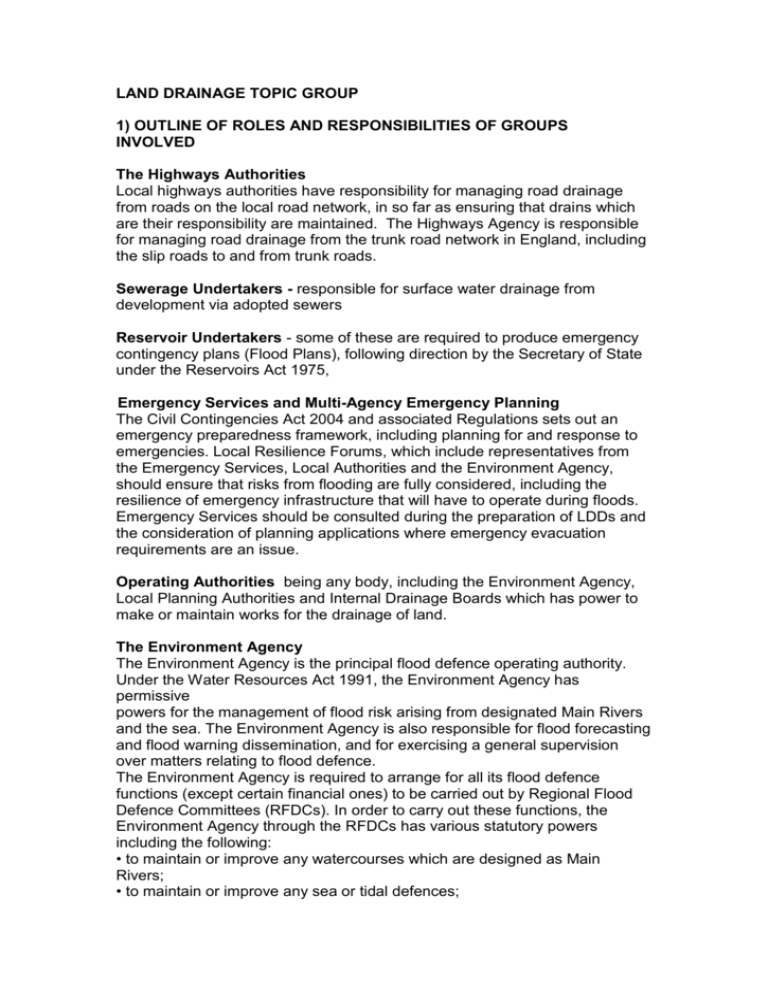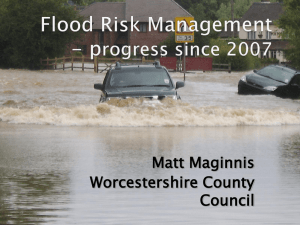LAND DRAINAGE TOPIC GROUP 1) OUTLINE OF ROLES AND
advertisement

LAND DRAINAGE TOPIC GROUP 1) OUTLINE OF ROLES AND RESPONSIBILITIES OF GROUPS INVOLVED The Highways Authorities Local highways authorities have responsibility for managing road drainage from roads on the local road network, in so far as ensuring that drains which are their responsibility are maintained. The Highways Agency is responsible for managing road drainage from the trunk road network in England, including the slip roads to and from trunk roads. Sewerage Undertakers - responsible for surface water drainage from development via adopted sewers Reservoir Undertakers - some of these are required to produce emergency contingency plans (Flood Plans), following direction by the Secretary of State under the Reservoirs Act 1975, Emergency Services and Multi-Agency Emergency Planning The Civil Contingencies Act 2004 and associated Regulations sets out an emergency preparedness framework, including planning for and response to emergencies. Local Resilience Forums, which include representatives from the Emergency Services, Local Authorities and the Environment Agency, should ensure that risks from flooding are fully considered, including the resilience of emergency infrastructure that will have to operate during floods. Emergency Services should be consulted during the preparation of LDDs and the consideration of planning applications where emergency evacuation requirements are an issue. Operating Authorities being any body, including the Environment Agency, Local Planning Authorities and Internal Drainage Boards which has power to make or maintain works for the drainage of land. The Environment Agency The Environment Agency is the principal flood defence operating authority. Under the Water Resources Act 1991, the Environment Agency has permissive powers for the management of flood risk arising from designated Main Rivers and the sea. The Environment Agency is also responsible for flood forecasting and flood warning dissemination, and for exercising a general supervision over matters relating to flood defence. The Environment Agency is required to arrange for all its flood defence functions (except certain financial ones) to be carried out by Regional Flood Defence Committees (RFDCs). In order to carry out these functions, the Environment Agency through the RFDCs has various statutory powers including the following: • to maintain or improve any watercourses which are designed as Main Rivers; • to maintain or improve any sea or tidal defences; • to install and operate flood warning equipment; • to control actions by riparian owners and occupiers which might interfere with the free flow of watercourses; and • to supervise internal drainage boards. The RFDCs are required to take an interest in all flood matters in their area and in particular to take decisions about the annual programmes of improvement and maintenance work to be carried out by the Environment Agency. Local Authorities Local authorities have certain permissive powers to undertake flood defence works and powers of enforcement under the Land Drainage Act 1991 on watercourses which have not been designated as Main Rivers and which are not within Internal Drainage Board areas. Internal Drainage Boards Internal Drainage Boards (IDBs) are independent bodies, created under various statutes to manage land drainage in areas of special drainage need. These areas include not only agricultural land but also large urban areas. Each Board operates within a defined area in which they have permissive powers under the Land Drainage Act 1991 to undertake flood defence works, other than on watercourses that have been designated as ‘Main’. 2) DUTIES AND POWERS OF THE COUNTY COUNCIL TO PROTECT AGAINST FLOODING Land Drainage Act 1991 The duties and responsibilities of the local authority and the Environment Agency are set out in the Land Drainage Act 1991. Local Authorities include all levels of councils. Generally the land owner is the person responsible for the land drainage of their land. Land Drains/ Watercourses are divided into Main Rivers and Ordinary Watercourses. Main Rivers are the responsibility of the Environment Agency and Ordinary Watercourses are the responsibility of the riparian land owner, i.e the owner of property adjoining a water course etc. Therefore HCC would be responsible for all authority owned land. If a riparian land owner fails to carryout maintenance on an ordinary watercourse then the Council can use powers under the Land Drainage Act 1991 to serve notice requiring them to undertake the necessary works. Failure to comply with such a notice may result in the Council undertaking the work and recharging the owner the costs of so doing and may also potentially expose the owner to liability for the cost of any damage caused by flooding. District Councils are responsible for ensuring that riparian owners discharge their duties under S14 of the Act. County Councils can only undertake this task where the District Council has asked them to do so or if the District Council fails to do so, (following not less than 6 weeks notice) (s16). Under S18, County Councils may, in accordance with the provisions of a scheme made by it or them under this section, enter on the land and carry out such drainage works as appear to it or them desirable, if it is of the opinion that any land is capable of improvement by drainage works, but that the constitution for that purpose of an internal drainage district would not be practicable. S20 of the act enables the county council to execute such land drainage schemes at the request of owners or occupiers who would benefit from the scheme, and at that person's expense. S25 provides the local authority which includes the county council , with the power to require works for maintaining flow of watercourse (unless the problem is due to mining operations). However under S26 before exercising this power the local authority shall, according to whether or not the watercourse or part is in an internal drainage district, notify either the drainage board for that district or the [Agency]. County Council's responsibilities as a Highways Authority As the Highways Authority, HCC will have responsibility for all flooding issues affecting County Highways (excluding trunk roads) i.e. they must deal with the causes of highway flooding where these concern blocked culverts and/or gullies that cause water to flood the road and affect property on either side. HCC as a Planning Authority - Planning Policy Statement 25(PPS25) Planning Policy Statements (PPS) set out the Government’s national policies on different aspects of land use planning in England. PPS 25 replaces Planning Policy Guidance Note 25: Development and Flood Risk. The policies in this PPS should be taken into account by regional planning bodies in the preparation of Regional Spatial Strategies; and, in general, by local planning authorities in the preparation of local development documents. They may also be material to decisions on individual planning applications. Regional Flood Risk Appraisals (RFRAs) Regional Planning Bodies should prepare RFRAs in consultation with the Environment Agency to inform their Regional Spatial Strategies (RSSs) on flood risk issues. By undertaking a strategic analysis of flood risk, RFRAs should inform RSS consideration of regionally significant uses, including the identification of broad locations and establishing locational criteria to highlight flooding issues that local planning authorities should address through their SFRAs. RFRAs should be informed by the Flood Map and appropriate plans prepared by the Environment Agency and other operating authorities (such as River Basin Management Plans, Catchment Flood Management Plans and Shoreline Management Plans). A RFRA should be used to inform the Sustainability Appraisal (incorporating the SEA Directive) of the RSS. Strategic Flood Risk Assessments (SFRAs) Local planning authorities (LPAs) and other decision-makers should prepare SFRAs in consultation with the Environment Agency, LPAs own functions of emergency response and drainage authority under the Land Drainage Act 1991, and where appropriate Internal Drainage Boards. Initially the SFRA will be used to refine information on the areas that may flood, taking into account other sources of flooding and the impacts of climate change, in addition to the information on the Flood Map. Decision-makers should use the SFRA to inform their knowledge of flooding, refine the information on the Flood Map and determine the variations in flood risk from all sources of flooding across and from their area. These should form the basis for preparing appropriate policies for flood risk management for these areas. Site-specific Flood Risk Assessments (FRAs) At the planning application stage, an appropriate FRA will be required to demonstrate how flood risk from all sources of flooding to the development itself and flood risk to others will be managed now and taking climate change into account. Policies in LDDs should require FRAs to be submitted with planning applications in areas of flood risk identified in the plan. The FRA should be prepared by the developer in consultation with the LPA. The FRA should form part of an Environmental Statement when one is required by the Town and Country Planning (Environmental Impact Assessment) (England and Wales) Regulations 1999 as amended.







